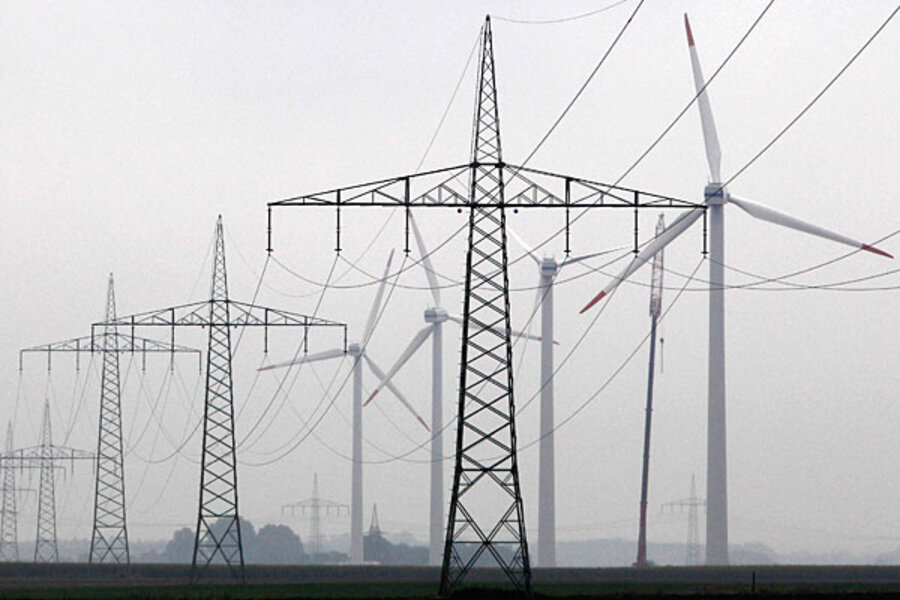Germany's green energy sector: can it grow without subsidies?
Loading...
| Berlin and Feldheim, Germany
Germany’s renewable energy sector has experienced a boom in the last decade that has far superseded expectations. Supported by generous subsidies, a public that is fairly open to green investments, and a widespread skepticism of nuclear power, energy producers have covered the country with wind generators and solar panels. Twenty percent of Germany’s electricity now comes from renewable sources.
But the industry risks becoming a victim of its own success. It is locked in a bitter debate with the government about the future of the subsidies that have allowed it to flourish. The government wants to severely curtail the financial support – particular for solar energy, which provides only 3 percent of Germany's electricity but receives about half the subsidies – although there are doubts the renewable energy industry could survive without it.
Feldheim, a tiny village just south of Berlin, is pretty, but otherwise unremarkable. Two dozen houses sit along a street lined with chestnut and maple trees. Nothing hints at why this place claims to be “the future” – but as the first energy self-sufficient village in Germany, and maybe the whole Continent, it just might be, says Werner Frohwitter.
Mr. Frohwitter’s company, Energiequelle GmbH, provides all of the town’s homes with heat and electricity generated from renewables at their doorstep, which feed into a local grid. Windmills rotate just behind the houses, a biogas plant on the outskirts provides heat and additional energy on windless days, and a bit farther down the road, rows of solar panels in a field face the dull winter sky.
Feldheim residents’ energy prices are 30 percent below the average in Germany. Energiequelle profits from feed-in tariffs, a subsidy on the amount of energy they feed into the system. It gives the company, as a renewable energy provider, a 20-year guarantee on the amount of energy they can feed into the grid at a price that is considerably higher than what fossil energy providers get on the free market.
It is a good deal for the company, and people outside Feldheim are noticing. The solar power industry is booming. The government predicted an increase in solar power installations in 2011 with a total output of 3.5 gigawatts, but actual production far exceeded that prediction: at the end of the year, Germany had produced an additional 7.5 gigawatts of solar energy.
The feed-in tariff is regulated by the Renewable Energy Bill and financed not by the state budget, but by German consumers. A levy dedicated to the support of green energy is added to the electricity bill of each household. It rises with the number of solar panels and windmills out there, even though the government tries to adjust the tariff downward at regular intervals. Last year, the average household paid €130 ($171) extra to foot the green bill.
“The production of solar panels has become much cheaper in recent years,” says Claudia Kemfert, energy expert with the German Institute for Economic Research in Berlin. “Manufacturers and providers can’t reasonably ask for subsidies much longer. But they are not competitive yet, compared to conventional energies.”
Overwhelmed by the green boom and under pressure from the conventional electricity utilities, the government has slammed the brakes on subsidies. Hardly a day goes by now without Economy Minister Philip Rösler asking the renewable energy sector for restraint in its demand for financial support. The feed-in tariff will now be adjusted every month rather than every six months, and subsidies for solar installations are scheduled to end in 2017 – five years before Germany shuts down its last nuclear reactor.
“The renewables can probably replace nuclear energy in Germany,” says Mrs. Kemfert. “But not coal, which generates most of our electricity. We will need a lot of new coal-powered plants in the next decades. And that means a rise in CO2 (carbon dioxide) emissions.”
High expectations of solar
By 2020, Germany wants 35 percent of its energy needs to be met with renewable sources, with solar energy contributing 10 percent. By 2050, renewables are meant to provide 80 percent of Germany's energy, and some experts believe that solar installations will deliver more than half of that.
Not everyone agrees. "Photovoltaic [energy] in Germany makes as much sense as growing pineapples in Alaska," said Jürgen Grossmann, CEO of Germany’s second-largest utility, RWE, at a conference in Berlin in January.
Clearly he was referring to Germany's limited sunshine. But even critics more sympathetic to renewables say that far too much money has gone into subsidizing wind and solar energy, and not enough into technologies needed to complement these, such as an up-to-date grid and energy storage.
DENA, the German energy agency, estimates that in order to connect all the planned new energy providers, including large offshore wind-farms in the North and Baltic seas, with customers across Germany, about 3,700 kilometers of high voltage network need to be built by 2025. In the past few years, a mere 100 kilometers of power lines were built.
Running Feldheim on renewables is one thing. Powering large urban areas, the whole economy even, is quite another, and many still doubt it can be done in the next few decades without the use of fossil energy sources.
“We need to put enough resources into research and development of a smart distribution grid and of energy storage facilities,” says Mr. Frohwitter of Energiequelle. “If we do that, we can supply all private German households with renewable energy in 20 or 25 years from now.”







